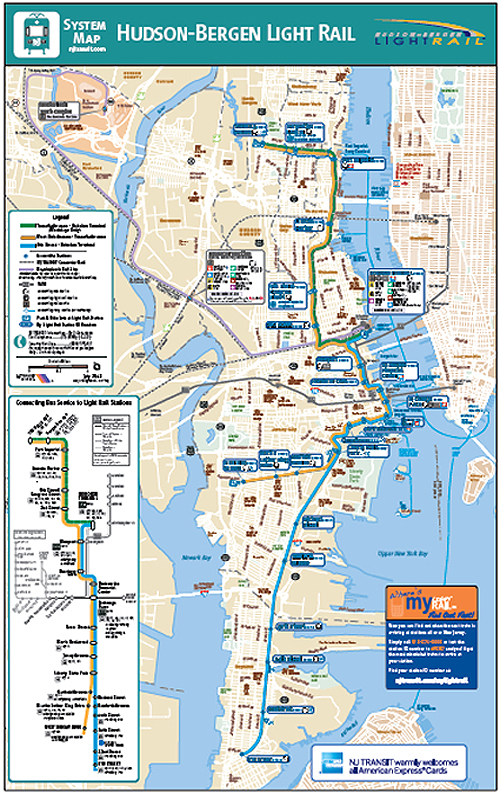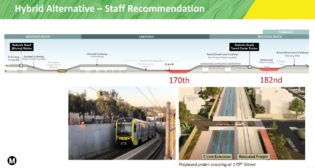
Hudson-Bergen Light Rail turns Sweet 16
Written by Alfred E. Fazio, Alfred E. Fazio, P.E., Contributing EditorIn April 2016, New Jersey Transit’s Hudson-Bergen Light Rail (HBLR) celebrates its 16th anniversary of operation. HBLR was the first successful DBOM (Design/Build/Operate/Maintain) deployment of a transit system in the modern era (post-World War II) and represents a throwback to when public-private partnerships were commonly utilized to build and operate railways.
Such notable systems as the initial two divisions of MTA New York City Transit (IRT and BMT), the original Newark City Subway, and the Baltimore & Ohio Railroad were so deployed.
HBLR was initially deployed by a defense contractor, Raytheon, during the administration of New Jersey Governor Christine Whitman. The system is currently operated by Twenty-First Century Rail (TFCR), a partnership of AECOM and Kinkisharyo USA. HBLR, today comprising some 20 route-miles, has become the progenitor for additional public-private ventures, such as the Denver Commuter Rail and Vancouver’s Canada Line, and most recently Ottawa’s new LRT.
One of the most important elements in DBOM deployments is continuity of corporate interest by the private partners. The consequences of investment decisions made within the allowable design/build criteria regarding design or construction judgments must be carried through to the operation. A flaw in DBOM potentially arises where the design/build lead firm exits the private partnership, thereby leaving the operations and maintenance group to somehow muddle through what may be less-than-optimal configurations or quality of work.
 On HBLR, even with the transition from lead partner Raytheon to Washington Group and ultimately to AECOM, the corporate interest, key personnel and the roles of the private partners have remained as they were at opening. Likewise, the customer (and owner), NJ Transit, continues to recognize the importance of working in partnership to deliver the highest quality of rail service. Importantly, working within the tight budget constraints facing the State of New Jersey, both parties have worked to find creative means of incrementally extending or otherwise enhancing the system, including the most recent extension to 8th Street in Bayonne. John Squitieri, NJT Assistant General Manager of Light Rail, notes that of all the modes, light rail consistently ranks highest on that agency’s Customer Service Index.
On HBLR, even with the transition from lead partner Raytheon to Washington Group and ultimately to AECOM, the corporate interest, key personnel and the roles of the private partners have remained as they were at opening. Likewise, the customer (and owner), NJ Transit, continues to recognize the importance of working in partnership to deliver the highest quality of rail service. Importantly, working within the tight budget constraints facing the State of New Jersey, both parties have worked to find creative means of incrementally extending or otherwise enhancing the system, including the most recent extension to 8th Street in Bayonne. John Squitieri, NJT Assistant General Manager of Light Rail, notes that of all the modes, light rail consistently ranks highest on that agency’s Customer Service Index.
The original DBOM was innovative in a number of ways. The Safety Certification, which is required by FTA of all new transit systems, was not signed by NJ Transit. Rather, it was executed by officials of Raytheon and Kinkisharyo and subsequently endorsed by NJ Transit. Likewise, a major routing change requested by the City of Hoboken in 1999, one that resulted in the three-way, elevated junction known as DEKALB, was jointly designed and implemented by both the public and private partners.
Also noteworthy was the original commissioning and start-up process (the “Rainbow Plan”) which now serves as an industry benchmark. Also, as part of the initial DBOM, which exceeded $1.5 billion in 1998 dollars, TFCR also built and equipped a one-mile extension and new vehicle base facility, and supplied some 20 HBLR-type LRVs to complete the evolution of the Newark City Subway system from a “streetcar in a subway” to modern LRT, Newark Light Rail.
The Operating Doctrine of HBLR reflects that of a high performance, electrified commuter railroad. It is noteworthy that the Bayonne Line was originally the main line of the Central Railroad of New Jersey, and the Weehawken Line originally operated as Conrail’s West Shore main to Selkirk, N.Y. Keeping with railroad practice, an employee timetable is issued and employees are required to qualify on summary physical characteristics. The signal system is cab/no-wayside with ATC and positive stop. The system provides for a theoretical clear capacity of 30 TPH (trains per hour) except at DEKALB, and a practical capacity of 20 TPH.
Although the FRA does not exercise regulatory jurisdiction, track and signals are inspected and maintained in conformance with Federal Standards. Phil Maccioli, President of TFCR, observes, “Though the light rail industry is not regulated by the FRA, as a best practice, NJT and TFCR conform to these standards. All track and signal systems are maintained and inspected to FRA standards. This provides our customers a higher standard of safety and reliability in their daily commutes.”
Also consistent with commuter rail, zone expresses such as the Bayonne Flyer are operated, and left-handed running is routinely employed.
As with all transportation systems, HBLR is strongly tied to redevelopment and economic growth. With the resurgence of the Jersey City waterfront (now sometimes referred to as the Gold Coast), ridership continues to grow. It now stands at more than 50,000 each weekday.
What of the future of this privately operated LRT? As growth continues a number of extensions remain in discussion, albeit informally. Ultimately, perhaps when the funding situation improves, the line will reach Bergen County. In anticipation of a northern extension, a section of triple-track main line—Three Roads—was constructed on the Weehawken Line to allow overtakes by Bergen County expresses. The overtake track is configured with No. 20 crossovers, allowing 45 mph diverging speeds.
For the near term, however, peak capacity on the core system is a challenge. To address this, NJT and TFCR have recently completed in-service testing of an expanded LRV, adding two additional sections to create a five-unit vehicle. Rebuilding of a portion of the fleet into “fives” will allow peak-hour operation of rush-hour consists of a five-unit and original three-unit, resulting in vastly more capacity.
Regardless of the challenges, 16 years of innovation, growth and successful safe operation give witness to the ability of this public/private team in New Jersey to continue to move forward.



